In Florida’s diverse ecosystems, 13 distinct species of hawks command the skies, each contributing to the intricate balance of the state’s avian population.
From the iconic Red-Tailed Hawk to the agile Cooper’s Hawk, these raptors exhibit various colors, sizes, and hunting strategies.
Florida’s unique geography and habitats provide a varied canvas for these majestic birds to thrive, encompassing woodlands, marshes, and open fields.
This compilation delves into the captivating world of these 13 hawk species, unraveling their individual traits, behaviors, and roles within the Sunshine State’s ecosystems.
Join us on a journey through the skies of Florida as we explore the fascinating lives of these aerial predators, shedding light on their importance and the conservation efforts needed to safeguard their presence in the region. Stay sharp.
13 Hawks of Florida
Check out the diverse avian residents of Florida, showcasing their unique characteristics and lifestyles.
Each bird plays a vital role in the state’s ecosystems, from the powerful Red-Shouldered Hawk to the winter visitor Rough-legged Hawk and the distinctive Northern Harrier.
Delve into the fascinating world of these raptors soaring across the Floridian skies.
1. Ferruginous Hawk
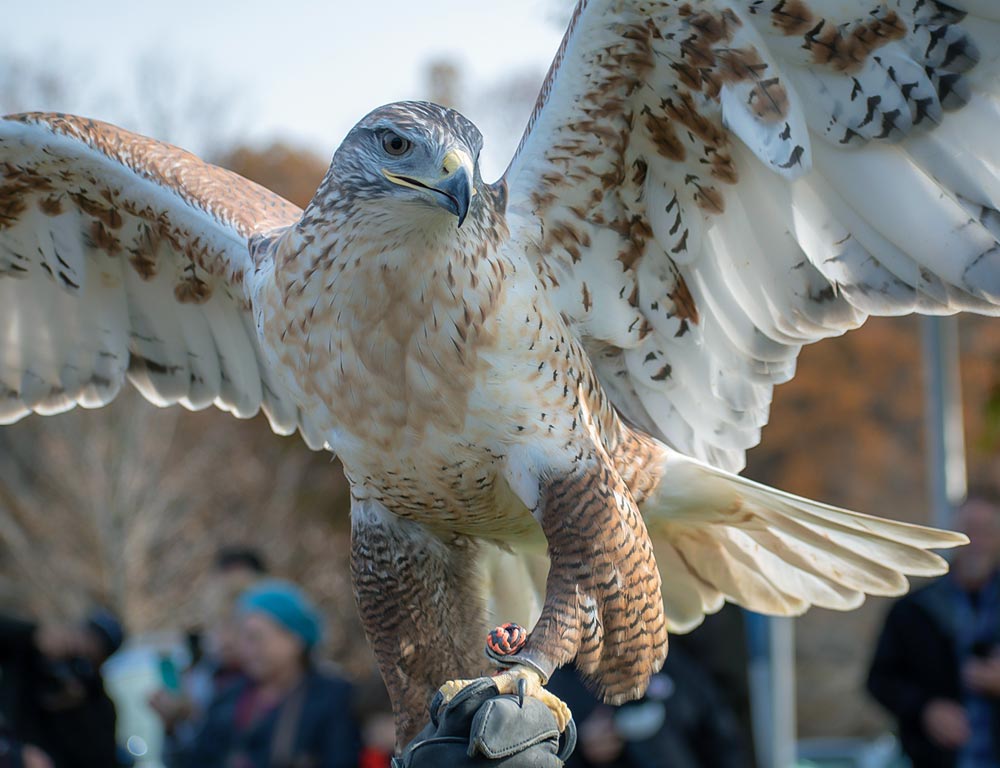
- Scientific Name: Buteo regalis
- Population: Generally stable
- Life Span: Up to 20 years
- Size: 22-27 inches
- Weight: 2-5 pounds
- Food: Mainly mammals like rabbits, ground squirrels, and birds
- Wingspan: 4.5-5.5 feet
The Ferruginous Hawk, with its striking rusty plumage on its legs and the back of its head, is a majestic raptor inhabiting the open landscapes of Florida.
These hawks are adapted to diverse environments, from deserts to grasslands. With keen eyesight, they spot their prey from great heights and swoop down with impressive speed to capture it.
Their diet consists predominantly of mammals, such as rabbits and ground squirrels, and occasionally includes birds. Known for their adaptability, Ferruginous Hawks exhibit a nomadic lifestyle, often moving to follow the abundance of their prey.
They build their nests on elevated areas, including cliffs or even utility poles. Despite their relatively long lifespan of up to 20 years, these hawks face threats from habitat loss and human activities.
2. Sharp-Shinned Hawk
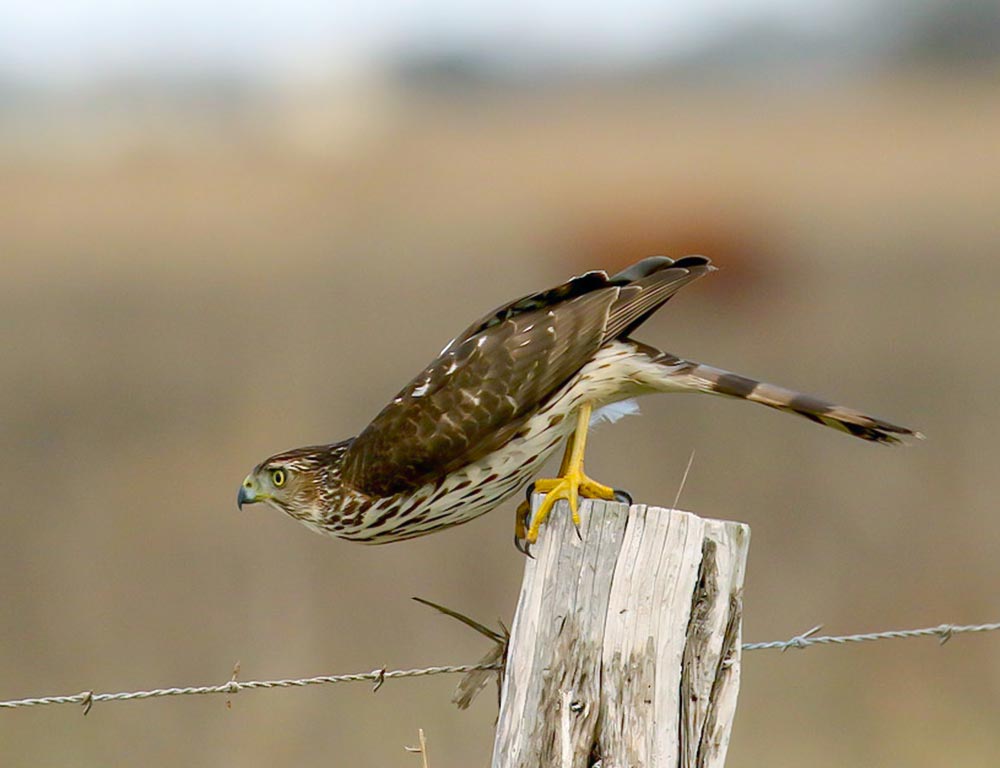
- Scientific Name: Accipiter striatus
- Population: Stable
- Life Span: Up to 10 years
- Size: 9-13 inches
- Weight: 3-7 ounces
- Food: Primarily small birds
- Wingspan: 17-22 inches
The Sharp-Shinned Hawk, a compact and agile predator, is a common sight in Florida. With short wings and a long tail, these hawks are built for swift, maneuverable flights through dense vegetation.
Their diet mainly consists of small birds, and they are known for their skill in capturing prey mid-flight. These hawks are territorial during the breeding season, establishing nests in wooded areas.
Despite their relatively short lifespan of up to 10 years, Sharp-Shinned Hawks play a vital role in controlling populations of songbirds and other small avian species.
Urbanization and habitat fragmentation challenge their survival, but their adaptability allows them to thrive in various environments.
3. Broad-Winged Hawk
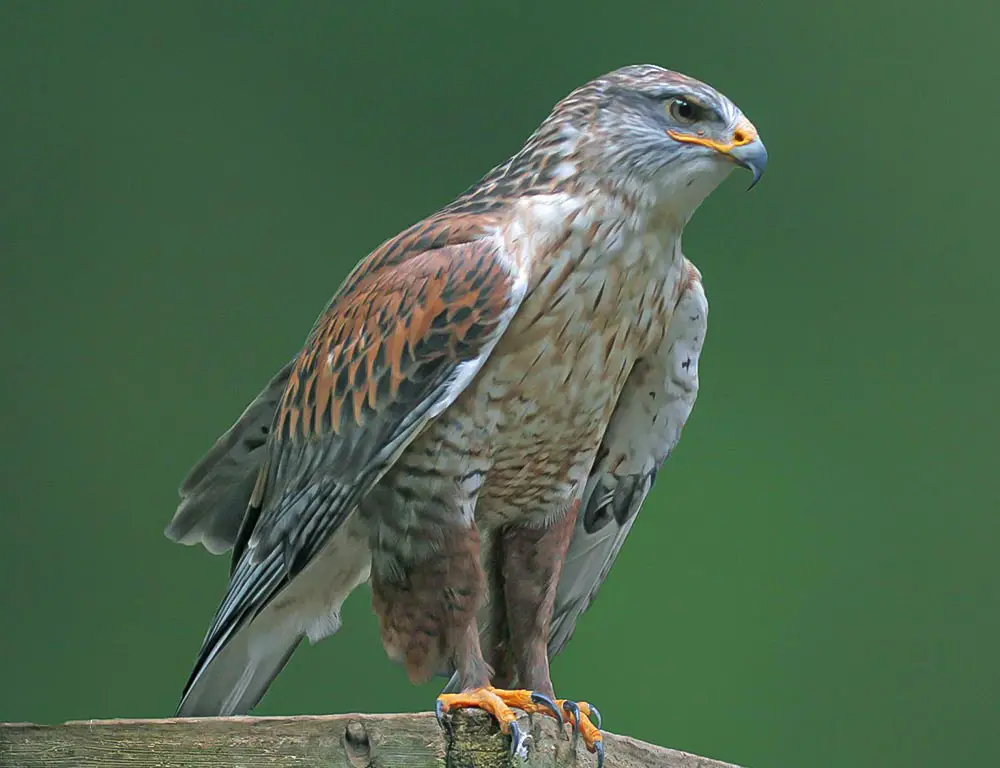
- Scientific Name: Buteo platypterus
- Population: Stable
- Life Span: Up to 7 years
- Size: 13-17 inches
- Weight: 9-20 ounces
- Food: Small mammals, reptiles, and amphibians
- Wingspan: 2.5-3 feet
The Broad-Winged Hawk, with its distinctive broad wings and short tail, is a migratory bird of prey found in Florida. These hawks cover impressive distances during migration, often in large groups called kettles.
Their diet includes small mammals, reptiles, and amphibians, and they are known for their soaring flight patterns.
Broad-winged hawks establish nests during the breeding season in deciduous or mixed forests, showing strong fidelity to their nesting sites.
They exhibit a monogamous breeding system, and both partners contribute to raising their young.
Despite their relatively short lifespan of up to 7 years, these hawks face habitat loss and pesticide exposure challenges. Conservation efforts are crucial to ensuring their continued presence in the Florida ecosystem.
4. Red-Tailed Hawk
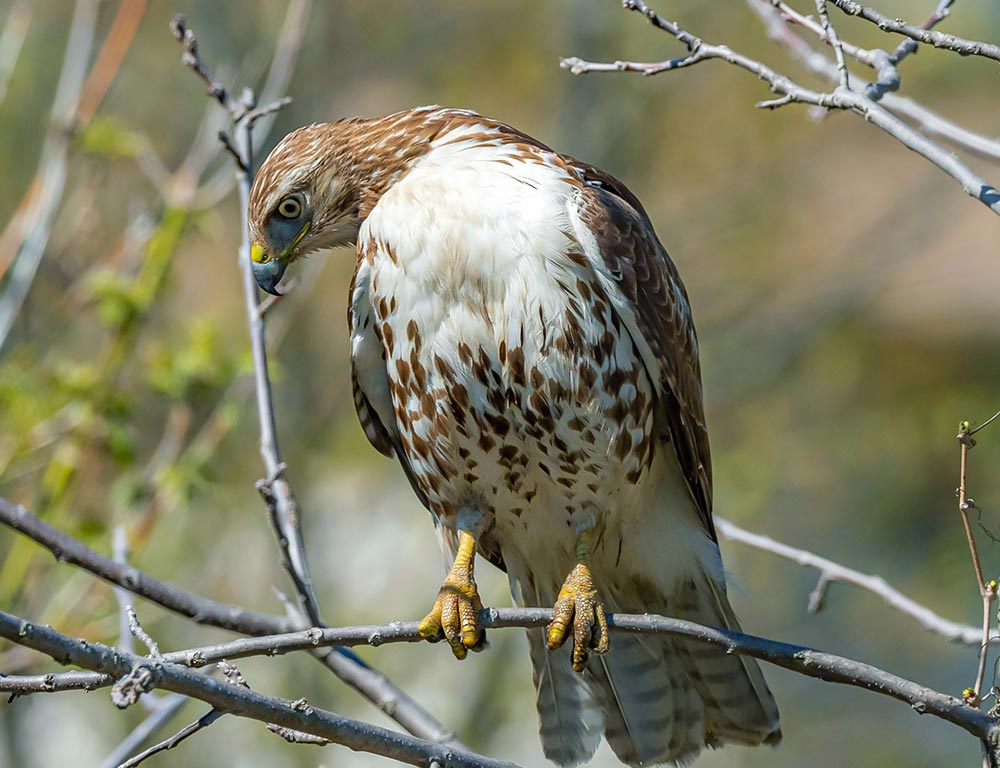
- Scientific Name: Buteo jamaicensis
- Population: Abundant and widespread
- Life Span: Up to 20 years
- Size: 18-26 inches
- Weight: 2-4 pounds
- Food: Mainly small mammals, occasionally birds
- Wingspan: 3.5-4.5 feet
The Red-Tailed Hawk, a common and adaptable species, is recognized by its distinctive brick-red tail. Found throughout Florida, these hawks occupy diverse habitats, from open fields to forests.
They soar at great heights with keen eyesight, spotting prey like rodents and rabbits. Red-tailed hawks are known for their versatile hunting techniques, utilizing perches or soaring flights to locate food.
These hawks are monogamous, and pairs may use the same nesting site for several years. Nests are often built high in trees or on cliffs.
Their long lifespan of up to 20 years allows them to contribute significantly to controlling rodent populations. However, they face threats from habitat loss and pesticide exposure.
5. Great Black Hawk
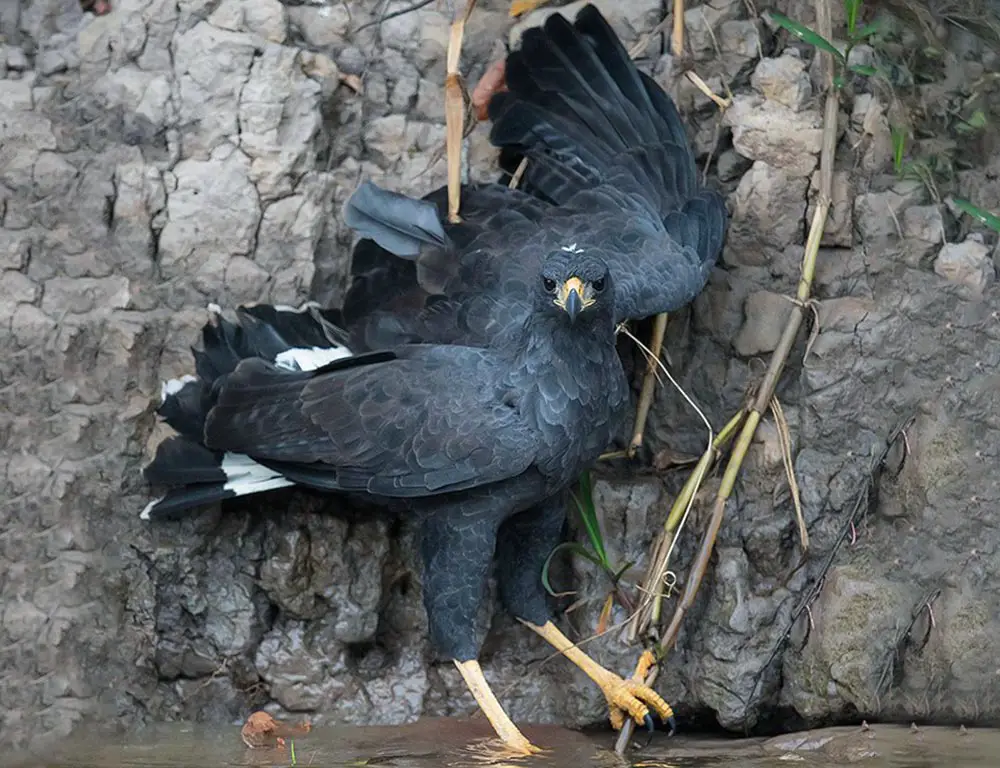
- Scientific Name: Buteogallus urubitinga
- Population: Declining
- Life Span: Up to 15 years
- Size: 22-27 inches
- Weight: 2.5-3.5 pounds
- Food: Fish, amphibians, reptiles, and small mammals
- Wingspan: 4.5-5 feet
The Great Black Hawk, native to tropical and subtropical regions, including Florida, is recognized by its entirely black plumage. These hawks are often found near bodies of water, hunting for fish, amphibians, and reptiles.
They are skilled hunters, using their powerful talons to capture prey. Great Black Hawks are known for their solitary nature, and their populations are currently declining, primarily due to habitat loss and environmental changes.
They build nests in tall trees, and both partners contribute to caring for the offspring. Despite their adaptability, conservation efforts are crucial to ensuring the continued presence of the Great Black Hawk in Florida.
6. Swainson’s Hawk
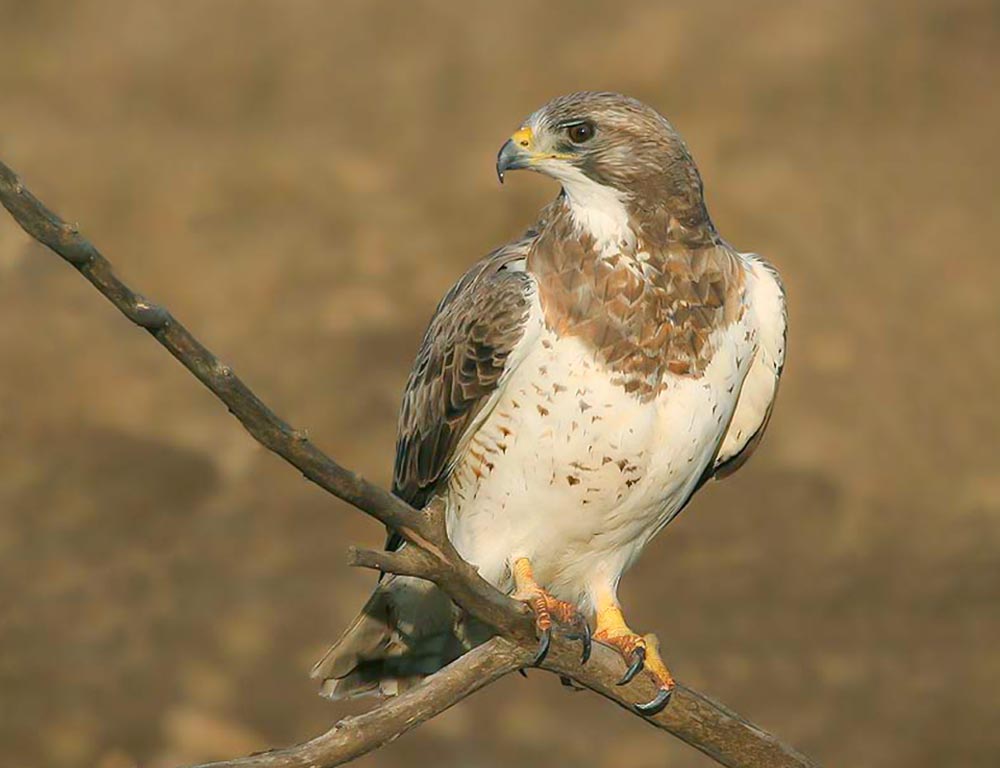
- Scientific Name: Buteo swainsoni
- Population: Stable
- Life Span: Up to 10 years
- Size: 18-22 inches
- Weight: 2-4 pounds
- Food: Insects, small mammals, and birds
- Wingspan: 4.5-5.5 feet
Swainson’s Hawk, with its distinctive light plumage and dark bib, is a migratory raptor that visits Florida during its journey. These hawks have a varied diet, including insects, small mammals, and birds.
They are often seen soaring in large groups during migration. Swainson’s Hawks build nests on the ground or low vegetation by breeding in open habitats.
They are known for their long-distance migration, covering thousands of miles between their breeding grounds and wintering areas in South America.
Conservation efforts are essential to protect their habitats during migration and breeding seasons.
7. Northern Goshawk
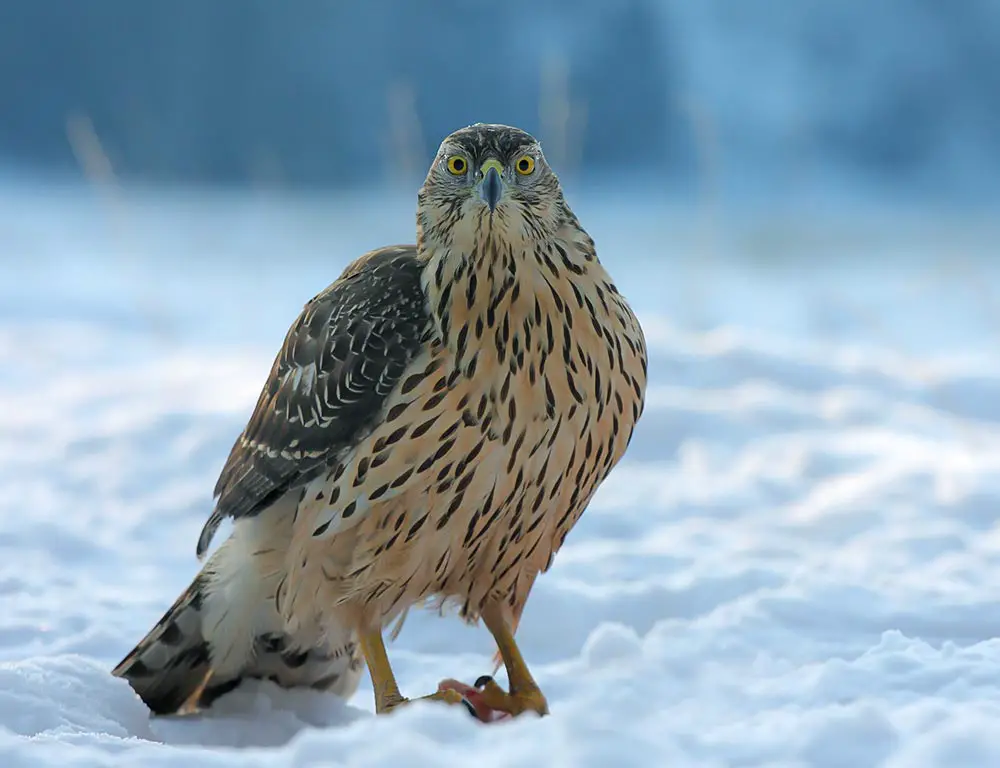
- Scientific Name: Accipiter gentilis
- Population: Varied, some populations declining
- Life Span: Up to 15 years
- Size: 20-26 inches
- Weight: 1.5-3.5 pounds
- Food: Birds and mammals
- Wingspan: 3.5-4.5 feet
The Northern Goshawk, a powerful and elusive bird of prey, is found in various forested habitats in Florida. These hawks primarily feed on birds and mammals, using their sharp talons to capture prey precisely.
Known for their agility in flight and stealthy hunting tactics, Northern Goshawks play a vital role in maintaining balanced ecosystems. During the breeding season, they construct nests high in trees, showing strong territorial behavior.
Northern Goshawks are highly adapted to forested environments, and their populations may be affected by habitat fragmentation and disturbance.
Conservation efforts are crucial to ensuring the preservation of their habitats and the sustainability of their populations in Florida.
8. Cooper’s Hawk
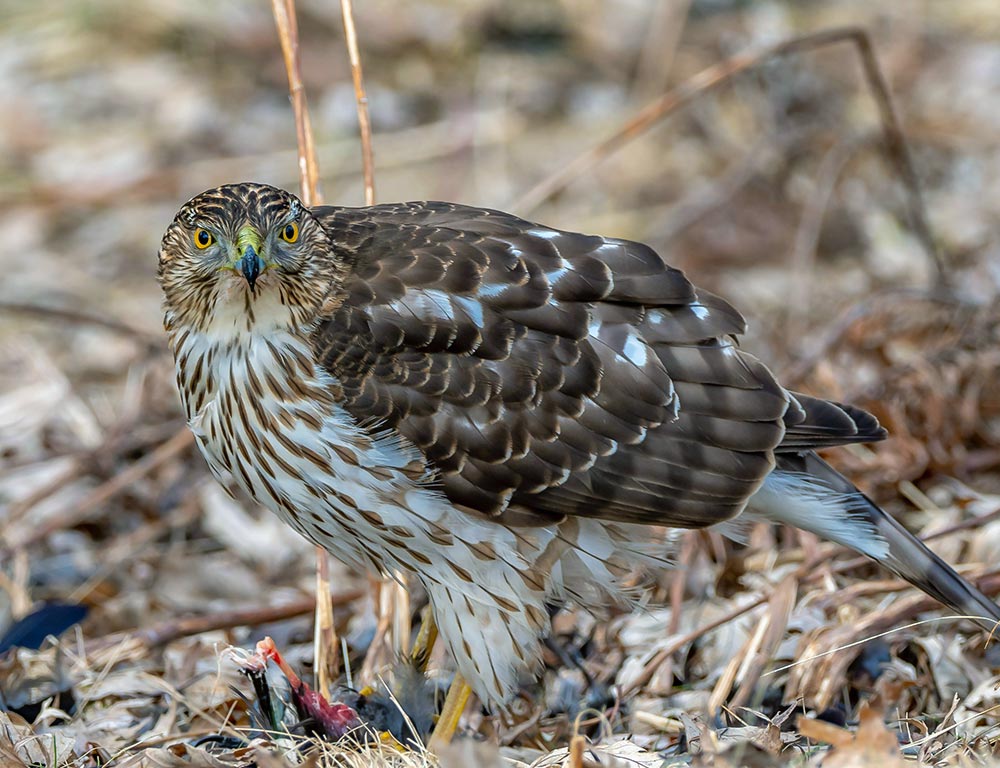
- Scientific Name: Accipiter cooperii
- Population: Stable
- Life Span: Up to 12 years
- Size: 14-20 inches
- Weight: 7-24 ounces
- Food: Mainly birds, especially small to medium-sized birds
- Wingspan: 2.5-3.5 feet
Cooper’s Hawk, characterized by its slate-gray back and rusty-barred chest, is a woodland raptor commonly found in Florida.
Adapted for agile flight through dense vegetation, these hawks primarily prey on birds, utilizing surprise attacks and rapid pursuits through trees. They are known for their ability to navigate through dense cover while hunting.
Cooper’s Hawks build nests in trees, and their breeding pairs often remain together for multiple seasons.
They play a vital role in controlling bird populations, particularly in suburban and urban areas where they are known to frequent backyard bird feeders.
While their populations are generally stable, these hawks may face habitat loss and pesticide exposure challenges.
9. Short-Tailed Hawk
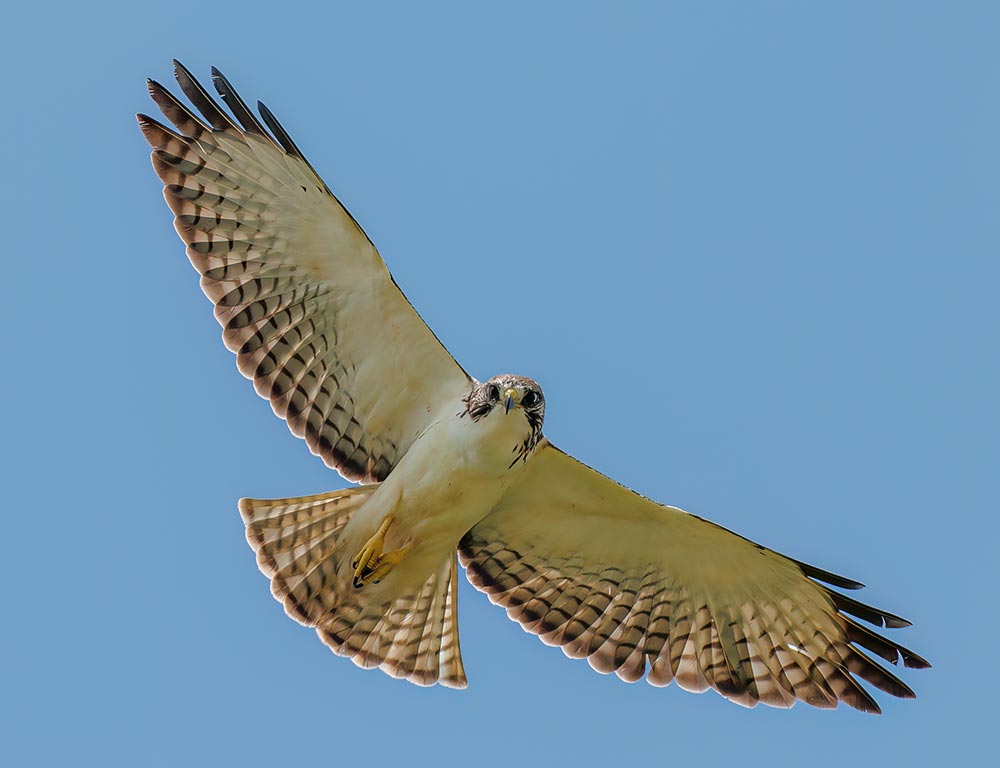
- Scientific Name: Buteo brachyurus
- Population: Stable
- Life Span: Up to 12 years
- Size: 15-20 inches
- Weight: 12-24 ounces
- Food: Birds, especially small to medium-sized birds
- Wingspan: 3.5 feet
The Short-Tailed Hawk, a distinctive raptor with a boldly banded tail, is a resident of Florida’s subtropical and tropical regions.
These hawks primarily feed on birds, soaring at great heights and using their keen eyesight to locate prey. They are often observed hunting over open fields, marshes, and forests.
Short-tailed hawks build nests in tall trees, often near water, and both partners contribute to nest-building and raising their young. They are known for their adaptability to various habitats, including coastal areas.
While their populations are generally stable, ongoing conservation efforts are essential to safeguard their habitats and ensure the continued presence of this unique hawk in Florida.
10. Zone-Tailed Hawk
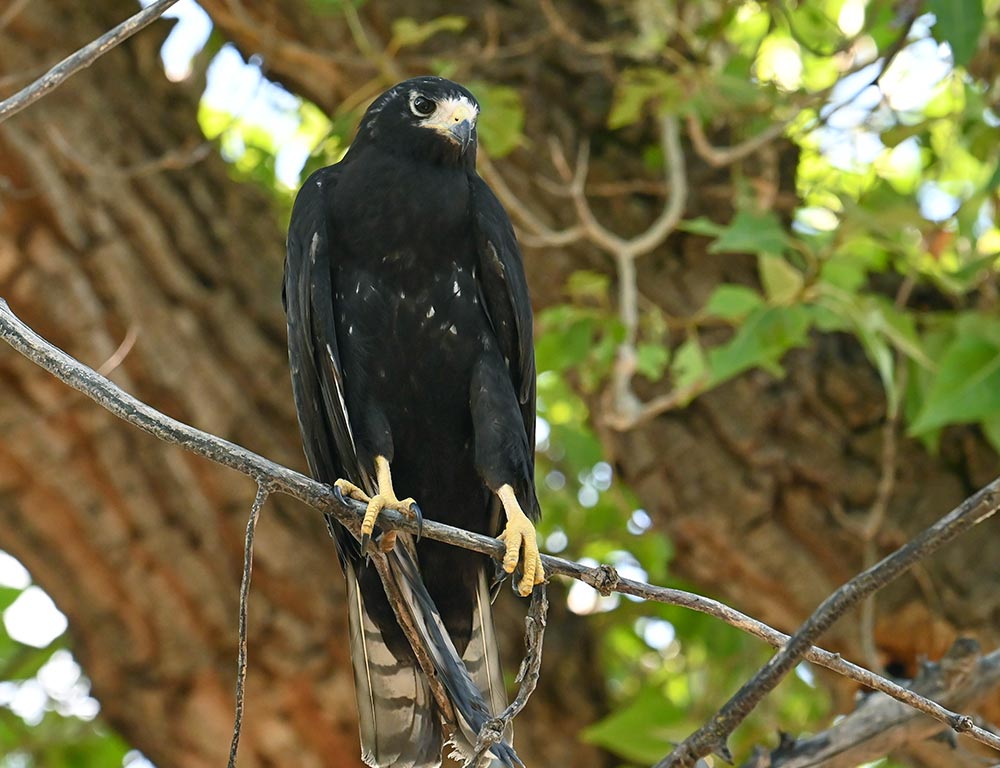
- Scientific Name: Buteo albonotatus
- Population: Stable
- Life Span: Up to 12 years
- Size: 18-22 inches
- Weight: 1.5-2.5 pounds
- Food: Birds and small mammals
- Wingspan: 3.5-4 feet
Like a vulture in flight, the Zone-Tailed Hawk is found in various habitats in Florida, including woodlands and canyons.
Known for its mimicry of vulture flight patterns, these hawks often surprise their prey with sudden attacks. Their diet consists of birds and small mammals, and they are known for their hunting agility.
Zone-tailed hawks build nests in trees, usually at moderate heights. They may be observed soaring in thermal updrafts, similar to vultures while searching for prey.
Despite their mimicry, they are formidable hunters and play a role in controlling rodent populations. While their populations are generally stable, preserving diverse habitats is crucial to sustaining their populations in Florida.
11. Red-Shouldered Hawk
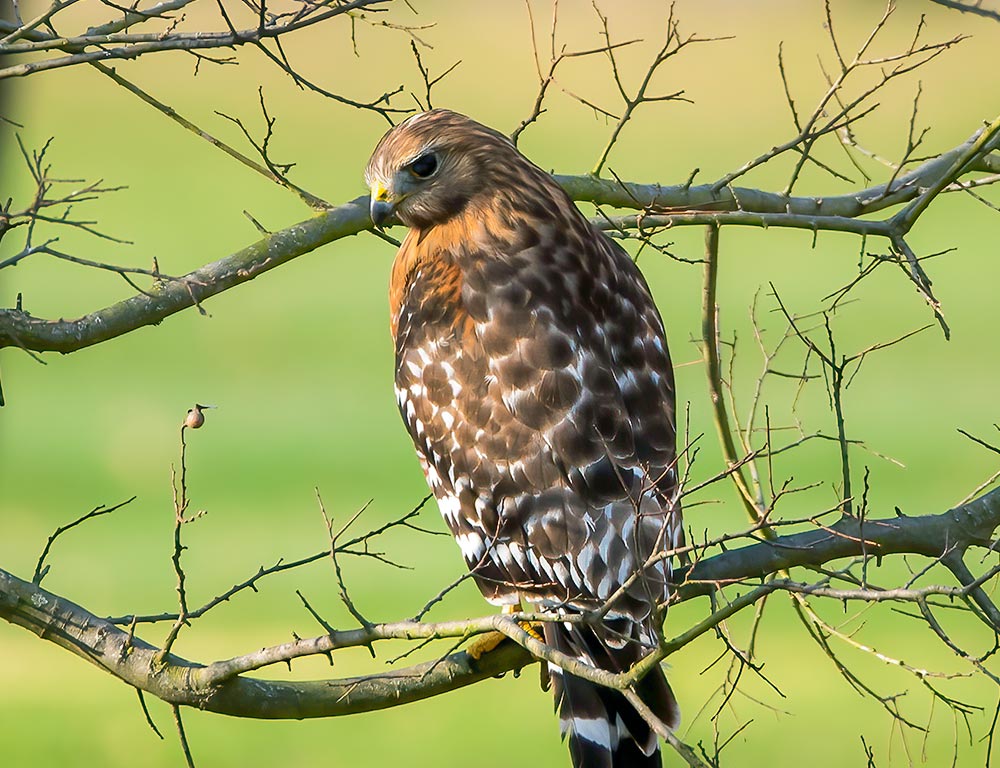
- Scientific Name: Buteo lineatus
- Population: Stable
- Life Span: Up to 15 years
- Size: 17-24 inches
- Weight: 1-2 pounds
- Food: Small mammals, amphibians, reptiles, and birds
- Wingspan: 3.5-4.5 feet
The Red-Shouldered Hawk is a distinctive raptor known for its vibrant reddish-brown shoulders.
Found in various habitats, including woodlands and forests in Florida, these hawks are skilled hunters with a diverse diet that includes small mammals, amphibians, reptiles, and birds.
They are often heard calling with their distinctive loud, piercing screams. Red-shouldered hawks are territorial during the breeding season, building nests in tall trees.
They are known for their elaborate courtship displays, which involve aerial acrobatics. Both partners contribute to raising their young.
Despite their relatively long lifespan of up to 15 years, they face habitat loss and pesticide exposure threats. Conservation efforts are crucial to maintaining healthy populations of Red-Shouldered Hawks in Florida.
12. Rough-legged Hawk
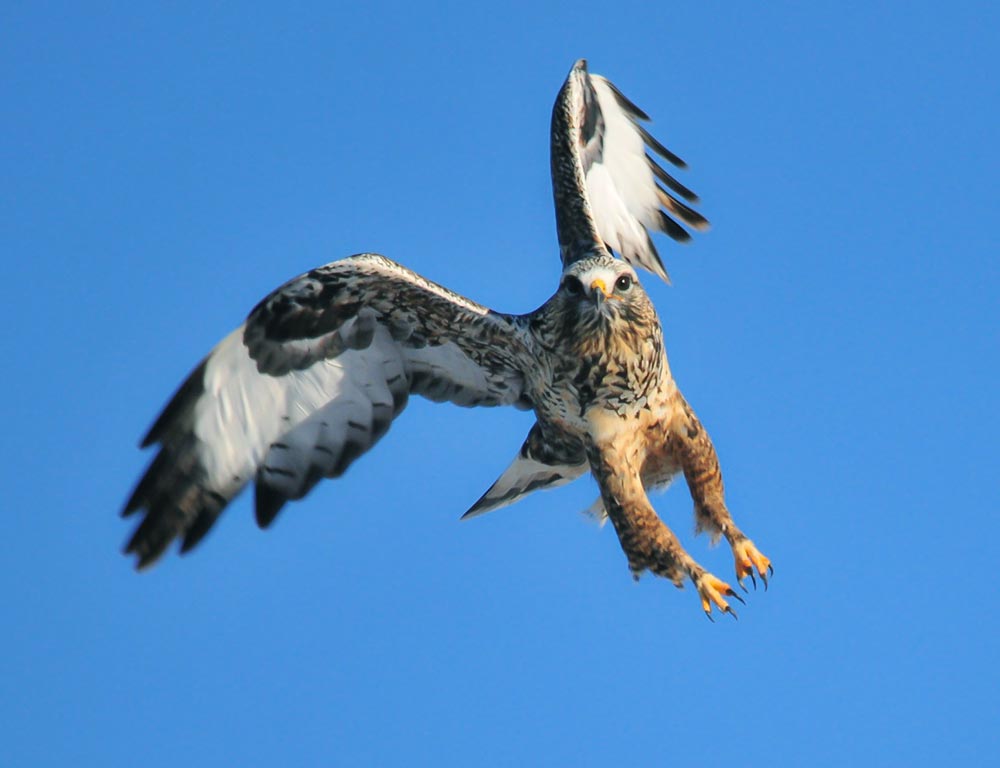
- Scientific Name: Buteo lagopus
- Population: Varied, some populations declining
- Life Span: Up to 10 years
- Size: 18-24 inches
- Weight: 1.5-3 pounds
- Food: Small mammals, especially rodents
- Wingspan: 4.5-5 feet
The Rough-legged Hawk, adapted to northern climates, is a winter visitor to Florida. Recognized by its feathered legs, these hawks primarily feed on small mammals, especially rodents.
They are often seen perched on elevated positions or soaring gracefully over open areas during winter. Rough-legged Hawks build nests on cliffs or trees in their Arctic tundra breeding grounds.
Their populations may face challenges due to habitat loss in both breeding and wintering areas. Despite their varied plumage, ranging from light to dark morphs, their hunting behavior remains consistent.
Conservation efforts are essential to protect their winter habitats in Florida and address potential threats to their populations.
13. Northern Harrier
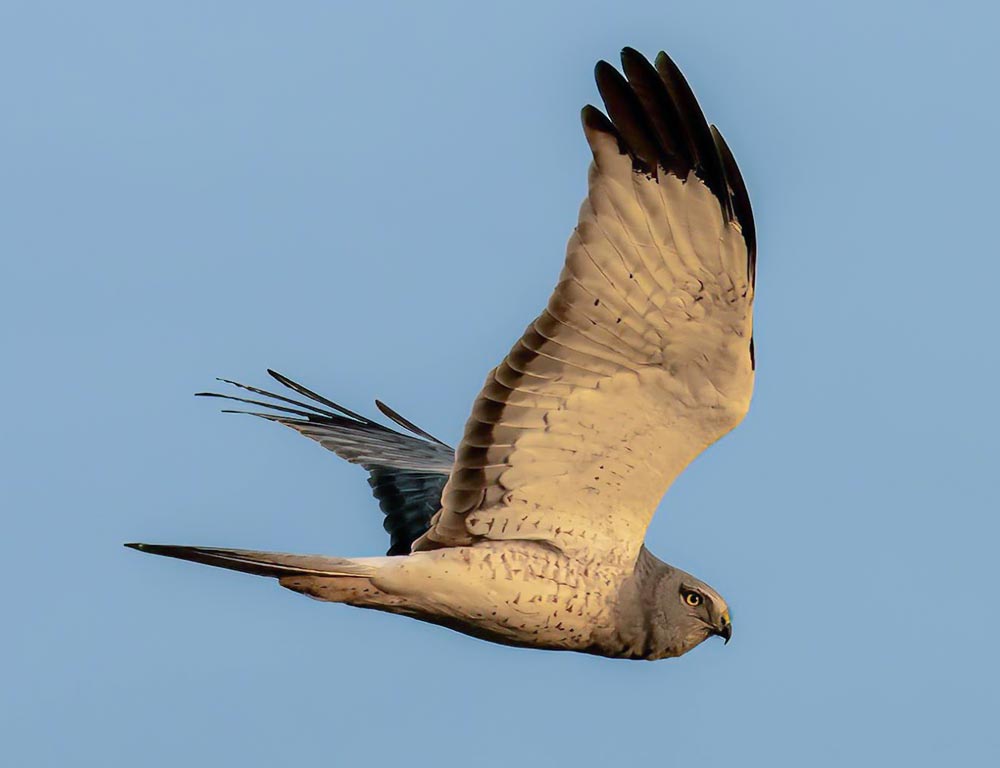
- Scientific Name: Circus hudsonius
- Population: Varied, some populations declining
- Life Span: Up to 12 years
- Size: 18-20 inches
- Weight: 10-26 ounces
- Food: Small mammals, birds, and amphibians
- Wingspan: 3.5-4 feet
The Northern Harrier, known for its owl-like facial disc and low cruising flight, is a distinctive raptor found in Florida’s marshes, grasslands, and open areas.
These hawks primarily feed on small mammals, birds, and amphibians, using their keen sense of hearing to locate prey. Northern Harriers build nests on the ground in dense vegetation. They are known for their low, gliding flight as they hunt over open landscapes.
During the breeding season, males perform aerial displays to attract females. Their populations may face challenges from habitat loss, especially in areas with extensive agricultural development.
Conservation efforts are essential to maintain suitable habitats and ensure the survival of Northern Harriers in Florida.
Wrapping Up
A tapestry of hawks graces Florida’s skies, each contributing to the state’s ecological harmony.
From the vibrant Red-Shouldered Hawk to the winter visitor Rough-legged Hawk and the stealthy Northern Harrier, these raptors exemplify the diversity and resilience of Florida’s avian inhabitants.
Their unique lifestyles, nesting habits, and hunting techniques reflect the intricate balance within the Sunshine State’s ecosystems. Conservation efforts are paramount to ensuring these magnificent birds’ continued presence and well-being.
As guardians of the skies, their stories weave into the broader narrative of Florida’s natural wonders, inviting us to appreciate and protect the rich biodiversity that soars above. Best of luck.